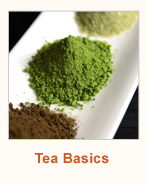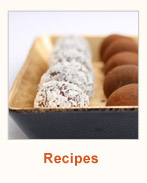
Beginner's Tea Tour - The Basics
Our beginner's tea tour is meant as a brief, informative and intriguing introduction to the basics of tea. We hope to inspire you to learn more, broaden your global tastes, and connect with other "leaf" enthusiasts. So learn, drink and enjoy!
The Common Denominator - Camellia sinensis
Camellia sinensis is the biological classification for the tea plant. This group of small trees and flowering evergreen shrubs is the source of ALL true teas. Whether black, oolong, green or white, they are all produced from the same tealeaves. The simple explanation for what distinguishes these four different tea types is the particular processing method used.
Tea Processing - From Plucking to Packing
Once the leaves have been plucked from the tea bush, they undergo various processing techniques resulting in the production of black, oolong, green or white teas.
There are two methods for manufacturing tea - orthodox and CTC (Cut, Tear, Curl). The orthodox method is used to make loose teas while the mechanized CTC method is used to finely cut tea leaves for mass tea bag production.
The Orthodox Method
The orthodox method involves the steps of withering, rolling, oxidation, and drying.
Withering: The freshly harvested tea leaves are spread out onto trays through which air is evenly circulated. This removes most of the moisture in a uniform manner (up to 70%, depending on the growing region) while still preserving the leaf. As the moisture evaporates, the leaves become soft, limp and pliable, preparing them for rolling.
Rolling: The withered leaves are then placed into a rolling machine where they become twisted and break open, exposing their juices and enzymes to air, which begins and enhances oxidation. In the highest quality tea, this process is done by hand.
Oxidation: Also known as fermentation, oxidation is the natural chemical reaction that is responsible for turning a tea into black, oolong or green. It is a crucial stage in the process and begins when the essence of the crushed leaves is exposed to air. The twisted and wiry looking leaves are spread out in a temperature and humidity controlled room during which time the color of the tea leaves deepens from green to a reddish-brown, and then to nearly black. Once the desired level is reached, the oxidation process must be halted, which is done by several different methods, depending on the region.
Drying: To stop the oxidation process, the leaves are dried, also known as firing, which is done in a variety of ways. In Japan, the leaves are steamed and dried. In China, the leaves are stir-fried in woks or dryers and sometimes even smoked over burning pine needles. In India, the leaves are placed in big dyers and tumbled dry. During the firing process, the leaves also become dehydrated which prepares them for storage, grade sorting, and packing.
The CTC Method
Invented during World War II, the CTC method (Cut, Tear, Curl) of tea manufacturing doesn't have a rolling stage, but instead uses big machines with hundreds of sharp, little teeth that literally cut, tear, and curl the withered tea leaves into small, grainy pieces. The leaves are then fired to remove almost all of the remaining moisture. This method provides quick processing for a high volume of tea leaves, which is commonly used in the mass production of tea bags.
Tea Profiles - Black, Oolong, Green, White and Herbal
True Teas: Black, Oolong, Green and White
Black, Oolong, Green and White teas are considered to be true teas.
Black Tea Basics
Description: Black teas are the most commonly produced teas in the world and are produced in over 30 countries. Offered in a multitude of tastes, strengths and aromas, its versatility promotes wide use in iced tea mixes and blends. Well known variations of this popular tea include Assam, Darjeeling, Earl Grey and Keemun.
Main Growing Regions: India, Sri Lanka and China
Processing: Most processed; fully oxidize in two weeks to one month.
Color: Dark or black in color due to complete fermentation prior to firing.
Flavor: Fullest bodies and strongest flavors of all tea groups. Described as having a bold, tangy, spicy, or malty character, depending on the origin. Unique in that that it taste better with age; its flavor is preserved for several years while other teas usually loose their flavor within eight to nine months.
Antioxidant Levels: Rich in antioxidant polyphenols.
Caffeine: Highest level of all teas, but still 1/2 to 1/3 less than a cup of coffee.
Preparation: Whether loose or bagged, the water should be boiling and the tea should steep for 3 to 5 minutes. Over steeping will cause a bitter tasting tea.
Oolong Tea Basics
Description: Pronounced "woolong", its name comes from Chinese word meaning "Black Dragon". The finest oolongs are completely processed by hand and its leaves are often rolled into long curly leaves or ball-like form similar to gunpowder tea. It is commonly served in Chinese restaurants, to accompany dim sum and other dishes.
Main Growing Regions: Taiwan and the Fujan province of China
Processing: Semi-fermented; partially oxidized within two to three days, falling between the standards for black and green teas.
Color: Distinctive golden, light brown color.
Flavor: Strikingly unusual flavor with a delicate sweetness; reminiscent of the aroma of a peach. Described as mildly aromatic with a full bouquet.
Antioxidant Levels: Rich in antioxidant polyphenols.
Caffeine: Medium levels; between black and green teas.
Preparation: Generally offered in loose leaf form, the water should be just short of boiling and the tea should steep from 3 to 5 minutes, adjusted for personal taste.
Green Tea Basics
Description: Sencha is the most popular of Japan's green teas. Among the finest and most expensive grades of sencha is gyokuro, which means "pearl dew". At the other end of the sencha spectrum is bancha, the lowest grade of green tea. Matcha is a fine, expensive, stone ground, powered green tea used particularly in the traditional Japanese tea ceremony, as well as to dye and flavor foods such as mochi, soba noodles, green tea ice cream and a variety of Japanese confections.
Main Growing Regions: China and Japan
Processing: Green tea is oxidized very briefly by application of heat-either with steam, a traditional Japanese method, or by drying on hot pans, the traditional Chinese method. These teas are processed within one to two days of harvesting.
Color: Ranges from light, pale green to bright green. The darker green the leaves, the higher the quality.
Flavor: There are many varieties of green teas and each has their own distinct flavor; some are sweeter and others are more astringent. Green teas from China have a smoky or toasty flavor while green teas from Japan have a grassy or herbal taste.
Antioxidant Levels: Extremely high. The beneficial effects of green tea are attributed to disease fighting antioxidants called polyphenols, particularly catechins, which are present in higher quantities than in oolong or black teas due to the differences in processing. EGCG is the most abundant catechin in green tea, accounting for a bout 65% of its catechin content.
Caffeine: Lower levels; less than black and oolong teas. Because the caffeine it contains is more active, it is more stimulating than Black tea.
Preparation: Whether loose or bagged, the water should be just short of boiling and the tea should steep from 3 to 5 minutes, adjusted for personal taste.
White Tea Basics
Description: White teas are the rarest and most expensive teas in the world and were once reserved for emperors and nobility. While all true teas contain disease preventative antioxidants called polyphenols, white tea contains the highest concentration as they have undergone the least amount of processing. Typically, March and April are the only months that this rare tea is harvested.
Main Growing Regions: Produced only on a limited scale in China and Sri Lanka.
Processing: Most minimally processed of all teas; it undergoes no oxidation, only withering and light steaming and drying.
Color: When plucked, the curled-up tea buds are still covered by fine, silvery white hair, hence the name white, although the color of the dried tea is actually pale green.
Flavor: Most delicate-tasting of teas; brewing produces aromas and flavors that are subtle and light. The taste is similar to the green tea, but sweeter and milder.
Antioxidant Levels: Highest; richer in antioxidant polyphenols than green tea.
Caffeine: Low levels; less than black, oolong and green teas.
Preparation: To preserve the tea's delicate nature, the water should be just short of boiling and the tea should steep only 30 to 60 seconds.
Herbal Teas: Rooibos and Others
Herbal tea, more formally called tisane, is an infusion made from anything other than the leaves of the tea bush, including fresh or dried flowers, leaves, seeds, or roots. Although herbal teas are not derived from the Camellia sinensis plant and therefore not considered true teas, they still contain healthful properties, especially stimulant, relaxant and sedative effects. Rooibos, also known as red tea, is specially mentioned here as it is becoming increasing popular for its uniquely powerful antioxidant properties and wide ranging health benefits.
Rooibos Tea
Description: Pronounced "ROY-boss", it comes from the Afrikaans word for "red bush". It is not a tea in the traditional sense as it does not come from the Camellia sinensis plant. Instead, it is a legume and it belongs to the same family as the bean and the pea. Rooibos tea was first consumed by African Bushman hundreds of years ago and was then marketed to the rest of the world in 1904 by a Russian immigrant settler. Although it is not a true tea, it contains significantly high levels of powerful antioxidants similar to green tea as well as numerous trace minerals including zinc, fluoride, calcium and copper which boosts the immune system, slows the skin's aging process, and acts as an anti-allergen and anti-spasmodic, among many other health benefits.
Main Growing Regions: Western Cape Town region of South Africa
Processing: Like black tea, it is fully oxidized. There is also green rooibos, which is produced by a method similar to that of green tea, but it is more expensive.
Color: Distinctive reddish brown color.
Flavor: Unique, mild taste; naturally sweet and slightly nutty.
Caffeine: None; popular with pregnant women and nursing mothers.
Preparation: Whether loose or bagged, the water should be boiling and the tea should steep for 3 to 5 minutes.
To learn about the healing properties of tea and herbal tisanes, please visit our Health & Longevity area.



















